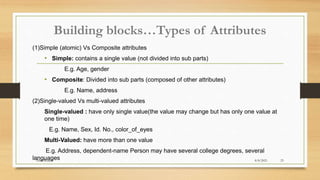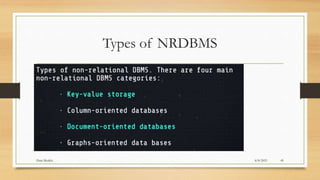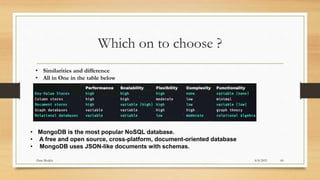The document discusses different data models including hierarchical, network, and relational models. It provides details on each model such as their structure, advantages, and disadvantages. The relational model is the most popular and extensively used model. It represents data in tables with rows and columns, and defines relationships between tables using primary and foreign keys. The document also describes the basic building blocks of a relational model including entities, attributes, relationships, and constraints.
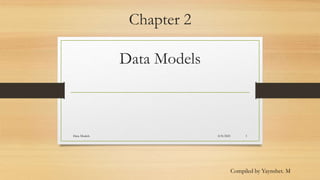





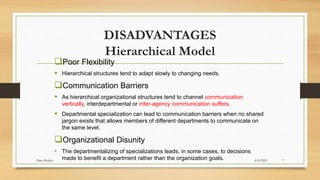
![Network Model
• In the network data model, all the entities are organized in graphical representations.
• There may be several parts in the graph in which the entities can be accessed.
• Data is represented by collection of records
• Relationships among data is represented by links
• Record is a collection of attributes, each which contain only one data value.
• The link is an association between two records
• Allows record types to have more that one parent unlike hierarchical model
• A network data models sees records as set members
• Each set has an owner and one or more members
• Like hierarchical model network model is a collection of physically linked records.
• Allow member records to have more than one owner [multi-connection way of business
entities] 8/8/2021
Data Models 8](https://image.slidesharecdn.com/ch2-slidedatamodels-230927065230-350123fb/85/ch2-slide-Data-Models-pptx-8-320.jpg)







![Properties of Relational model
• The REFERENTIAL INTEGRITY RULE of the model states that, for every
foreign key value in a table there must be a corresponding primary key value in
another table in the database or it should be NULL.
• All tables are LOGICAL ENTITIES
• A table is either a BASE TABLES (Named Relations) or VIEWS (Unnamed
Relations)
• Only Base Tables are physically stored
• VIEWS are derived from BASE TABLES with SQL instructions like: [SELECT ..
FROM .. WHERE .. ORDER BY]
8/8/2021
Data Models 16](https://image.slidesharecdn.com/ch2-slidedatamodels-230927065230-350123fb/85/ch2-slide-Data-Models-pptx-16-320.jpg)






